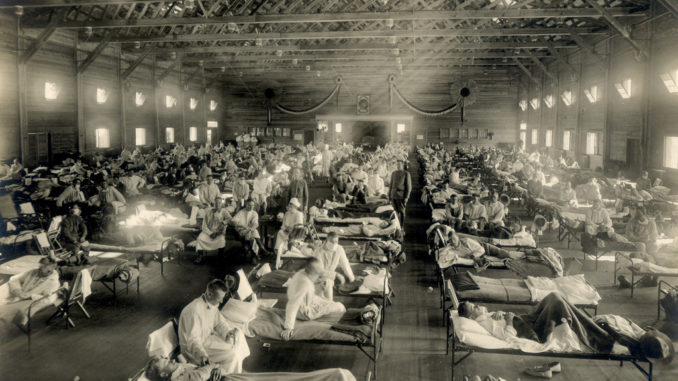
The Influenza Pandemic of 1918 in Northern Colorado
Meg Dunn
NorthernColoradoHistory.com
It was around mid-January 1918, in Haskell County, Kansas — about 300 miles southeast of Larimer and Weld counties — that a rural doctor began to notice a particularly bad flu among county residents. It was attacking even the strongest and healthiest people and knocking them flat on their backs. And for those whose influenza progressed to pneumonia, the result was deadly. Little did Dr. Loring Miner realize that the flu he was witnessing in that small agricultural community would end up spawning the worst influenza pandemic of the 20th century.
Somehow this new strain of flu had passed from animal to farmer, and from farmer to the community at large. For about a month and a half, the county was under siege until, in March, it had finally run its course. Dr. Miner felt like the cases he’d seen were unusual enough that once he was able, he sat down and wrote a description of the disease in an effort to alert the medical world that this flu seemed to be worse than the norm, and it could come back again. Little did Dr. Minor realize that it had already left Haskell County for Camp Funston (now Fort Riley), four and a half hours east, towards Kansas City. According to newspapers from the time, the flu had at least three opportunities to tag along with soldiers or their family members as they visited between Haskell County and Camp Funston. By March 4th, the first Camp Funston soldier was diagnosed with influenza.
As soldiers were deployed overseas, they carried the flu with them, until eventually England, France, Spain, and Germany were all overrun. But because of the war, these governments were loath to let their enemies know that an epidemic was ravaging their troops. So very little mention of it was made in public newspapers… except in Spain, which was a neutral country during World War I, so they didn’t care who knew what was going on among their army, or among their general populace for that matter. They published stories referring to the spread and devastation of the disease (which they believed had originated with the French). But, because the Spanish wrote of the illness, and the other nations didn’t (including the U. S., at least in the beginning), the sickness was given the name “the Spanish ‘flu.’” (The word “flu” often came with quotes around it. It’s likely people still generally referred to the sickness either as influenza or grippe, and the use of the term “flu” was still new.) Despite the moniker, there was still some doubt as to the origins, as shown by a Loveland Reporter article from October 30, 1918, which, though making clear the disease probably didn’t come from Spain, continued to refer to the disease as the Spanish flu throughout the entirety of the article.
“Although King Alfonso of Spain was one of the victims of the Influenza epidemic, in 1893 and again this summer, Spanish authorities repudiate any claim to Influenza as a ‘Spanish’ disease.” (Loveland Reporter, October 30, 1918)
After bouncing around Europe for a while, the original strain of influenza morphed into something even more dangerous and powerful than it had been when it first appeared in Haskell County. And as soldiers continued to be moved back and forth between the United States and Europe, the disease made its way back with them, landing first in the Boston area with soldiers at Camp Devens. A quarter of the camp fell ill and 757 men died. But the war was still going on and therefore troops continued to be shipped hither and yon. Which led eventually, to an outbreak at Camp Dix in New Jersey, where a shipment of Northern Colorado recruits arrived in late September.
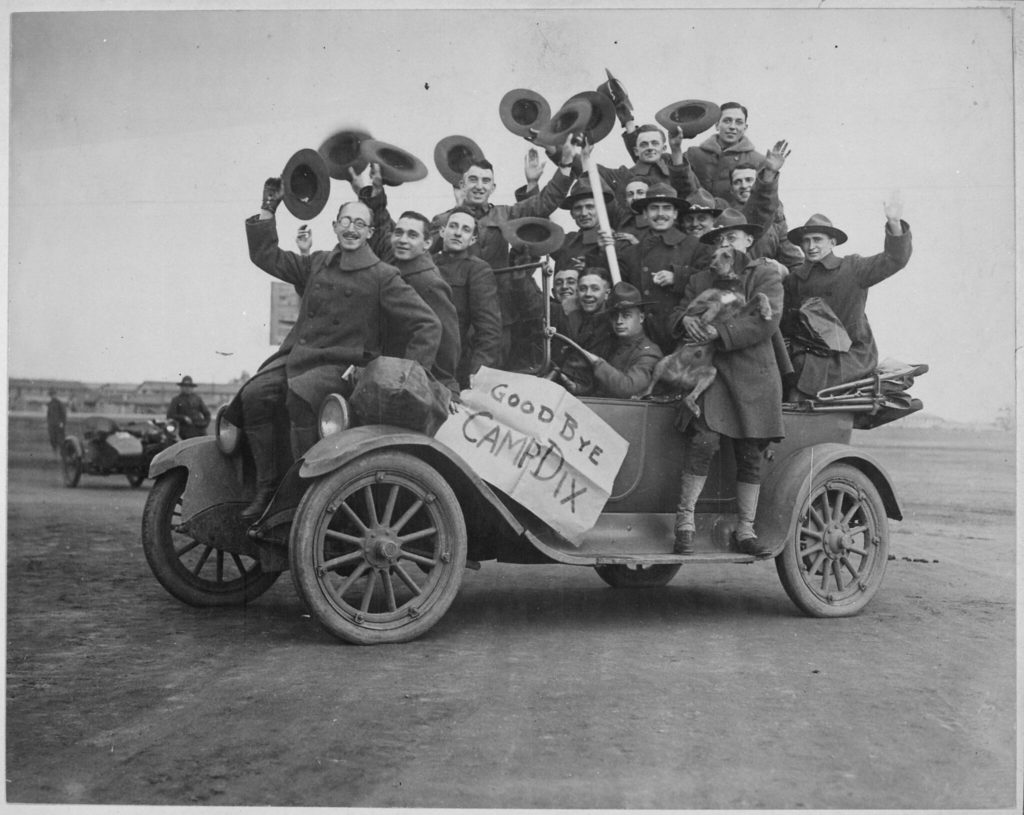
The recruits arrived at Camp Dix excited to be heading overseas for Uncle Sam. Little did they realize that their most fateful enemy was not in Europe but had arrived in Camp Dix before them. Five Northern Colorado soldiers, all new recruits, were shot down by influenza before ever coming in range of an enemy bullet.
Among the first to fall was Estel Lloyd Potts (22) of Loveland. On Saturday, his mother received a letter from him that didn’t mention anything about his being sick. On Monday, the family received a telegram that he was ill. On Wednesday, September 25th, he was dead.
Two Fort Collins area soldiers also succumbed on the same day as Lloyd. Strangely enough, both were named George Herman (and both of their fathers were named George T. Herman). This, at first, caused a great deal of consternation as neither family knew whether it was their George, or the other family’s George, who had passed. But in the end they were both horrified to discover that by some strange twist of fate, both of their sons had passed away on September 25th.
The very next day, Lucas Dreith (22), of Berthoud, part of the same Northern Colorado contingent, died from the flu.
And on September 27th, Albert Donovan, who grew up along Rural Route 2 in the Fort Collins area, joined the other four in death.
With at least two of these men, soldiers from Camp Dix accompanied their bodies home, potentially bringing the flu to Northern Colorado along with them. But influenza had another trajectory into the region as well.
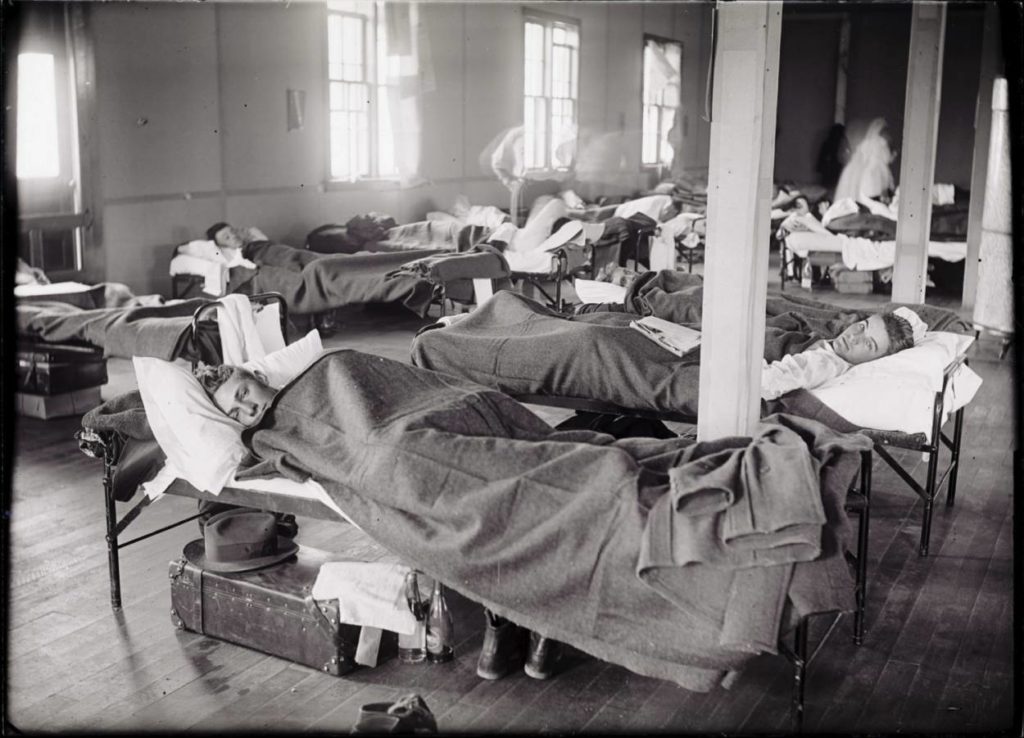
The Colorado Agricultural College (now CSU), as a land-grant college, had a mission to teach agriculture and mechanic arts, as well as classical studies. But they were also required to include military training. This requirement led to many land-grant colleges hosting training camps for soldiers during war-time. One avenue to increase voluntary enrollments in the military was to provide some college-level education as well. Thus the Student Army Training Corps (SATC) was created as an incentive to recruit more soldiers. Through the program, students took regular classes as well as military training.
The college inducted its first batch of SATC cadets on October 1, 1918. Though none appeared to have the flu at that time, two were sick and one dead by October 4th. There were 30 cases of influenza among the recruits by October 12th, and by the 14th, that number had skyrocketed to 94. As Kate Jeracki states in her article, 1918: When the Flu Came to CSU, “of 150 men who arrived on campus together, half were in the hospital within 24 hours.”
Campus was closed to civilians on October 24th, but military personnel remained in quarantine. Guards were posted to keep people from entering or leaving. At least 15 SATC trainees died of the disease as well as one faculty member. The quarantine on campus was finally lifted on November 21st with regular classes resuming. But for Northern Colorado, the on-campus military deaths were “the canary in the coalmine,” indicative of what was to come to the community at large.
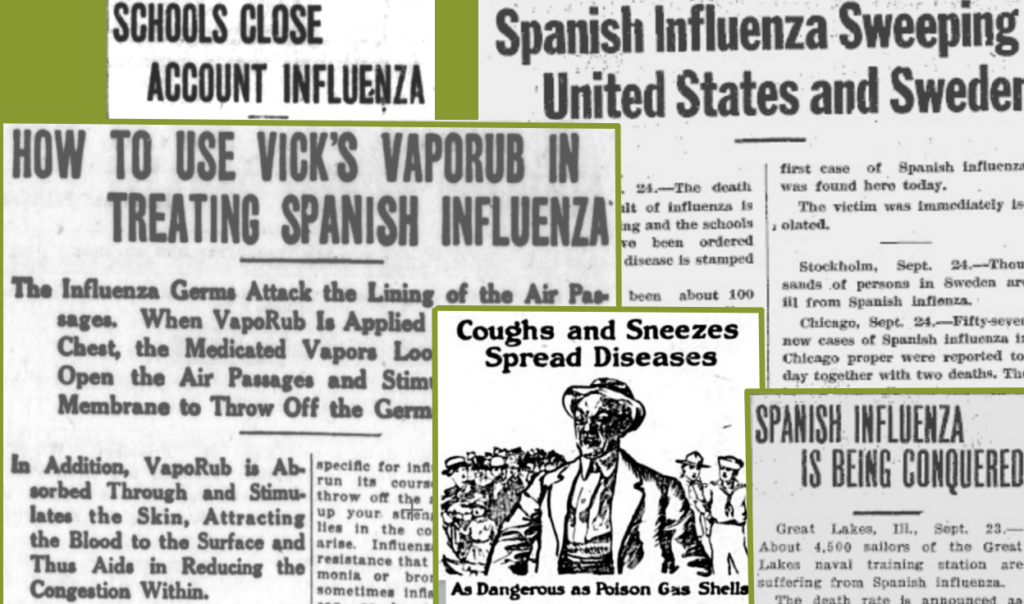
In addition to the first death among the soldiers at the Colorado Agricultural College, Roscoe Guernsey of Denver, a former resident of Fort Collins with many friends still in the area, passed away due to pneumonia caused by the flu on October 4th. The disease was becoming increasingly real to the people in Northern Colorado. It was time to start taking action.
On October 8th, Loveland closed their schools and prohibited public gatherings, including those taking place in theaters, churches, and fraternal lodges. Fort Collins and Laramie followed suit a day or two later. Even schools out in New Raymer, in east Weld county, were closed. Greeley and Boulder had both gone under quarantine by October 11th, and the editor of the Fort Collins Weekly Courier was calling for the leaders of Fort Collins to follow suit. People were battening down the hatches and preparing for the worst while hoping for the best.
Newspapers were keeping tabs on the number of known cases (at least 12 in Loveland by October 7th and 20 just two days later). On October 9th, the Loveland paper reported that cases weren’t spreading rapidly. And on October 11th, R. E. Wright, a Loveland physician, was quoted in the paper as saying that the situation was pretty much under control; there were only a few new cases. That same day the Fort Collins Weekly Courier quoted a local doctor as saying “that there are many people suffering from colds but not many with Spanish influenza and few of these serious.” (Fort Collins Weekly Courier, October 11, 1918)
Phew! Despite the hype and worrisome quarantine orders, Northern Colorado was going to be spared!
Or so everyone was fervently hoping. Little did they realize that the epidemic had only just begun.
The detailed mortality reports in the Loveland Reporter give testimony to how things went down. Laura May Deworlf (26) passed away on October 12th. Anna Kopp (25) and Marie Peterson (25) on the 15th. At this point, Loveland’s quarantine ban was extended.
Anna’s husband, Charles Kopp, followed the very next day. The community got a breather on the 17th, and then Frank Coleman (18) and Arthur Apgar passed on the 18th. Benjamin Skinner (35) and Clyde Kelly (29) passed on the 19th, and on the 21st, it was Isabella Kartes (42) and a Mrs. John Widerspon (a newlywed who was so new to the area that the newspaper reporter didn’t even know her first name). At this point, it was clear that the community’s hopes of remaining relatively out of the path of the epidemic were utterly unfounded. The hospital was bursting at the seams and the Elks Club offered their banquet room as an overflow hospital. The very next day, five patients had been moved into it.
Loveland seemed to have hit their apex on November 5th, with six people dying from the flu all in that one day: R. S. Baker (53), Willie Phye (4), Harry Phye (10), Roman Garcia (25), Navori Jiminez (12) and Helen Skold (13). But that wasn’t the end of it. Loveland’s 67th deaths due to the flu occurred on December 29th (about 1.34% of the population), the day before schools finally reopened. Though additional deaths continued into 1919, the worst was finally over.
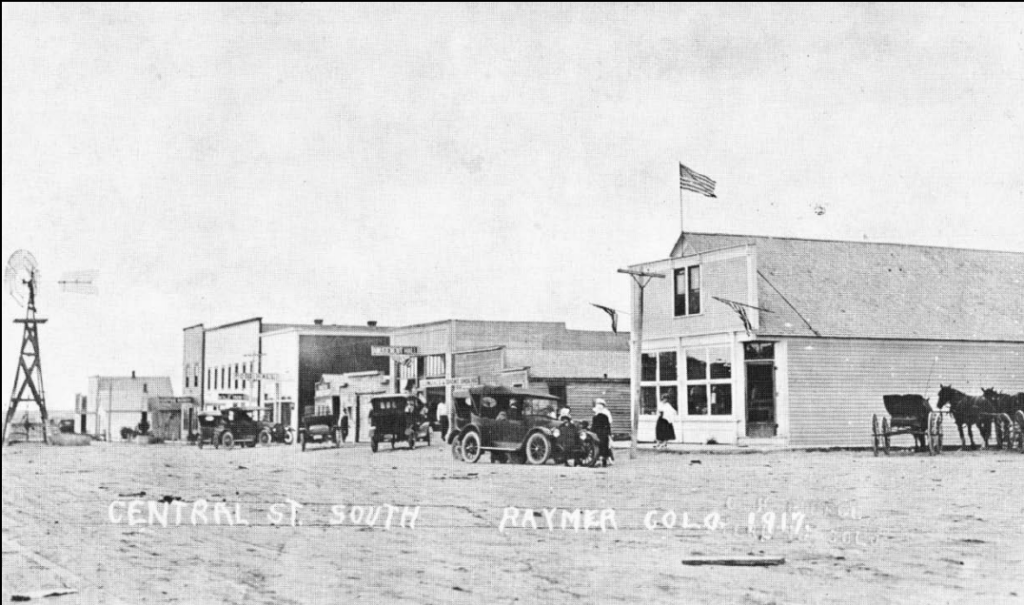
What happened in Loveland reflects what took place in Fort Collins and Greeley and in smaller communities such as Wellington, Windsor, Timnath and Berthoud. Even New Raymer, out on the plains, shows the same earlier hopes that the epidemic would be mild, followed by later firm acknowledgments that the epidemic was indeed powerful and horrific.
On October 17th, the Raymer Express stated, “The Influenza does not seem to be very serious in this section in most of the cases. The few that have shown symptoms of the disease get about in a short time, and there is every reason to believe that the disease will be under control in a very few days.” That hopeful announcement was followed only two weeks later by… “The very dangerous character of Influenza makes it necessary to use every proper precaution.”
Reality can be a harsh mistress.
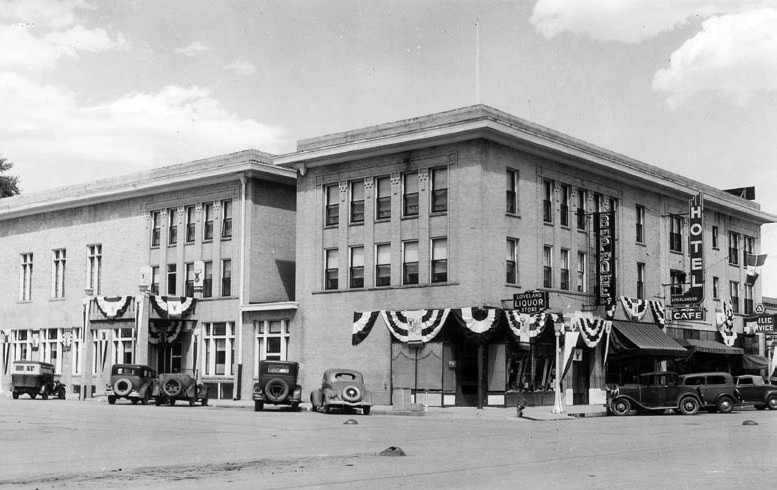
With schools, churches, and fraternal lodges closed, Northern Colorado residents adjusted to their new lives. They stayed home as much as possible, ordered items by telephone for pickup, and fashioned gauze into facemasks for when they had to go out (such as for grocery pickup or November elections). Sermons were printed in Saturday newspapers for Sunday morning services at home. But with priests and pastors busy with funerals and the consolation of family members, they weren’t always able to get their sermon to the printer in time. Food drives were organized to provide meals for families that had been especially hard hit. (When every member of the family is sick, none of them will eat unless food is brought in from the outside.)
During this time of fear, residents were eager to hear of a cure and many of dubious nature were printed in the newspapers. Tying a sachet soaked in camphor oil around your neck was supposed to keep the sickness at bay. Residents were told to stop burning leaves as the smoke could irritate the nose and throat and might make people more susceptible to the sickness. If you came down with a cold, there was a special diet one should go on to keep the cold from diminishing your defenses against the flu. (Breakfast — oatmeal gruel, crisp toast, and hot lemonade. Dinner — baked potato, poached egg, apple sauce. Supper — hot beef broth, baked custard. As the cold abates return to a regular diet that includes lots of fruits and veggies.) There was even one heater company that declared, “The best preventative is a Warm House. See those Heaters in our Store. Prices right.” In early November, the Loveland Reporter stated that flu patients require more sugar than healthy people. Though sugar was rationed during the war, extra permits were given to those who were sick. (Could this be where “a spoonful of sugar makes the medicine go down” came from?)
The Loveland Elks Lodge (which couldn’t hold meetings anyway due to the quarantine) generously offered its banquet hall for free as an emergency influenza hospital. From its creation around October 21st to the point when the City took it over on November 27th, the emergency hospital was staffed entirely by volunteers. By the end of November, they were sorely taxed and had apparently requested relief. It was at that point, during a City Council meeting (which were still held throughout the quarantine), that the volunteers were thanked and relieved and the City took over. The hospital continued to operate, caring for influenza patients until December 27th.
There’s one particular tragedy that took place in Loveland during the pandemic. Though there was hardly a family in Northern Colorado that wasn’t affected in some way by the flu — either because someone in their own family died from it, or a neighbor or a friend — the story of the Phye’s was one of overwhelming loss.
Charlie and Jessie May Phye had six children. Their oldest, Florence, had been married in February 1918 to Charles Wayman, though she had a 3-year-old son, Charlie Long, through a previous union. Next came five boys — Tommy, Harry, Bobbie, Davie, and Willie.
Around October 26th, Florence came up from where she lived, about a mile southeast of Berthoud, to visit with her family in Loveland. It was then that she caught the flu, possibly from her mother. Both were admitted to the emergency hospital located in the Elks Lodge on East 4th Street. The rest of the family were soon to follow, including little Charlie.
On October 30th, Jessie May succumbed to the flu. She was 41-years old. The next morning, November 1st, Florence (20) followed her in death. On November 2nd, Charles Phye passed, and on November 4th, 8-year old Bobbie followed. Willie (4) and Harry (10) both died on November 5th, Thomas (16) on the 7th, and Davie (6) on the 9th. In a matter of two weeks, the entire family had been stricken with the flu and almost entirely wiped out. Little Charlie Long was the only survivor. (He passed away in 2005 and was buried in Platteville, where he’d lived his life, having been raised by his father, Henry Long.)
The story of the Phye family has been immortalized as part of the CDC’s Pandemic Influenza Storybook.
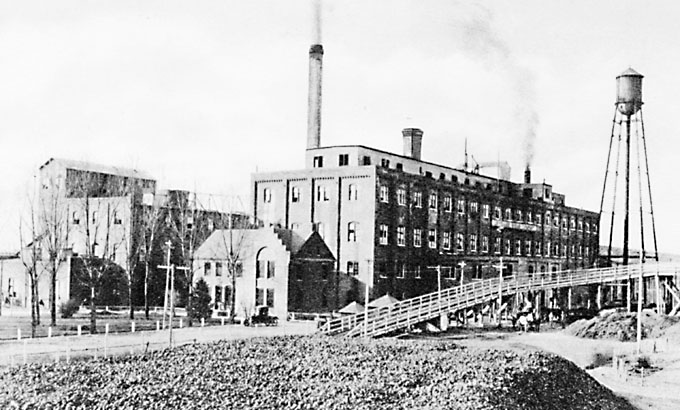
Autumn is when beets are harvested and sugar is processed. But the influenza epidemic hit at the beginning of October. There were reports of beets rotting in the fields because field hands and harvesters were not available to harvest them.
The sugar companies continued to process sugar, however, despite the quarantine.
In mid-December, it was reported that the sugar factories were offering free flu inoculations, and 200 Loveland employees had taken up the offer. The inoculator (a doctor that was employed by the sugar company) visited the Loveland sugar factory in the morning, headed north to the Fort Collins factory in the afternoon, then swung back by the Loveland plant in the evening to offer inoculations to the second shift of workers. The paper explained, “The sugar company has been much hampered in operations this season by the ravages of the influenza and if the new serum does all that is claimed the move will benefit the company as well as the employees by checking the epidemic.” (Loveland Reporter, December 11, 1918)
The jury is still out on whether these inoculations were worthwhile or not.
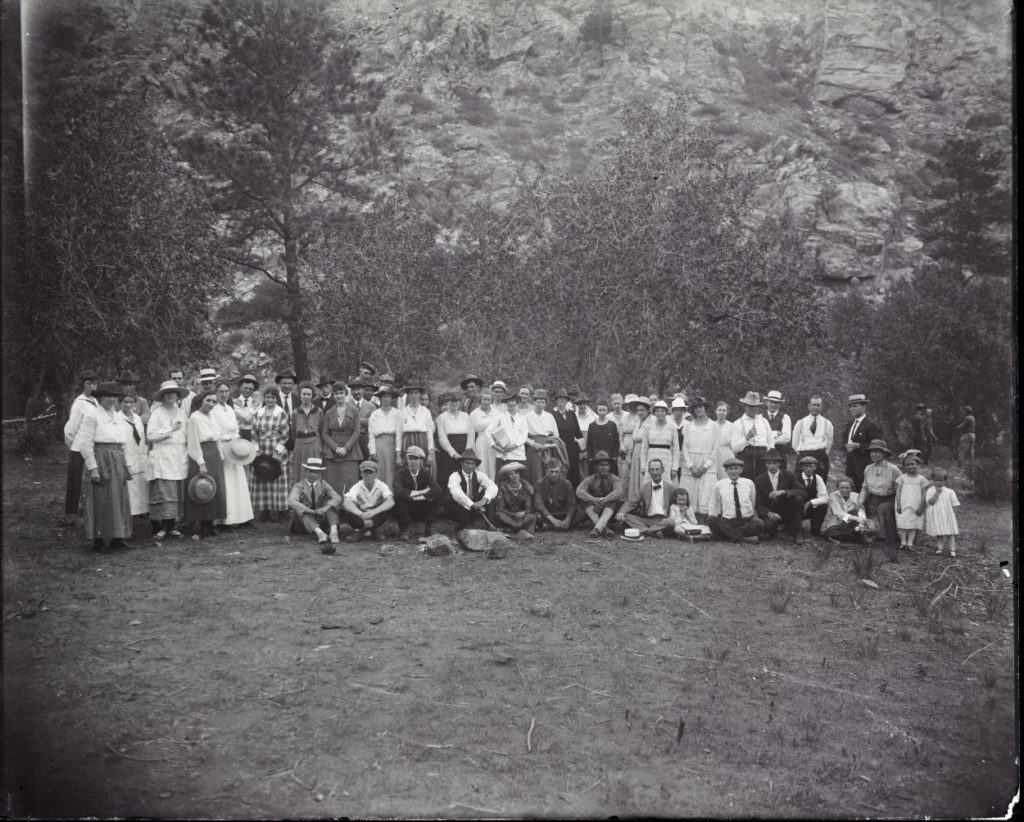
After a month under quarantine, Northern Coloradans were getting pretty sick of being cooped up. They wanted their lives back. And with new case numbers falling, many decided to do just that. It didn’t help that elections had rolled around in early November, and rather than being postponed, residents were encouraged to still congregate in polling places but to wear gauze masks as a preventative. With the message that it was okay to go out as long as you cover your mouth and nose, people felt freed up to bend the rules a little. And so the quarantine enforcement became lax, and folks began to socialize once more with occasional gatherings in the streets, social dinners, and even card parties.
The relaxing of the quarantine regulations showed and on November 15th, the Loveland Reporter announced that the City’s quarantine would not be lifted as people had hoped, and in fact, the reduced adherence to the rules had become apparent in a new uptick in cases. Just when Loveland was starting to see the light at the end of the tunnel, their relaxation of the rules plunged them back into the throes of the epidemic.
This on-again, off-again nature of the quarantine can be sensed in these excerpts from letters between two teenagers at the time, Winona Anderson and Dewey Koeper.
November 24, 1918 – There is a real quarantine in Collins now. You have to wear a mask when you go to town. They were going to have church today but couldn’t on account of the flu.
December 6, 1918 – This afternoon we are going to town. You can’t talk to anyone on the street unless you are thirty feet away from them. We don’t have to wear masks anymore though. The picture shows are shut up again. While they were on you had to wear a mask so I never went once.
(Thanks so much to Winona and Dewey’s granddaughter, Kathy Case Puter, for sharing these quotes!)
The November 29, Fort Collins Weekly Courier pointed out that the small community of Nunn had not endured one single case of influenza since the epidemic had reached Northern Colorado because they had enforced the “most drastic regulations ever known in any town.” And places such as Fort Morgan, that had managed to batten down their hatches, once the flu did sneak its way in (in late December), found themselves hit all at once and without warning. (Their quarantine had been to keep outsiders out, not to stop socializing with each other. So when the flu snuck its way in, it spread like wildfire.)
As of December 23rd, Loveland had lost 62 people to the flu (among a population of about 500), Fort Collins 126 (population about 8,700), and Greeley 200 (population around 10,900). Those weren’t the final numbers, but they do give a sense of the extent of the toll that was paid.
On December 9th, Loveland officially lifted its quarantine. Even theaters were allowed to reopen, though they were required to keep admissions to half of their capacity. Slowly, other institutions opened as well. The library opened on the 9th, but with reduced hours. Churches began to hold services again on December 10th. And soon, the papers were talking about the possibility of schools reopening, which they did on December 30th. The Owl Canon school managed to open for two days before being struck with another flu outbreak and shutting its doors once more. But for the rest of the schools, the quarantine was finally over. The students had been out of school for twelve weeks. This was partly offset by having the students come in one week that would otherwise have been during winter break, skipping spring break altogether, and adding an additional week to the end of the year.
Even after the worst of the epidemic was over and the quarantines were lifted, it still took awhile to get back to normal. The April 14, 1919 Fort Collins Courier told of a surprise birthday party held in Livermore for 70-year old Charlie Ramer. It added that, “After being shut in for several months on account of influenza everyone was more than glad to have the opportunity to get together again.”
Though the flu returned in 1919-20, and though some people still met their end due to the choke-hold of the disease, it was never again as bad as it had been during the fall of 1918. By February 2, 1920, the Fort Collins Courier declared “the Flu Beaten.”
But the post-traumatic stress remained. When a few cases of the mumps appeared in 1919, people were immediately on edge. When it looked like the flu might be coming back, people were much quicker to think about the value and importance of quarantine. And those who had survived the flu found that they had to be much more cautious with other illnesses as they appeared to be more susceptible than before to diseases such as tuberculosis and other respiratory illnesses. In July 1919, there was even a call for Congress to set aside $1,500,000 (or $25,696,490 in today’s dollars) to fight an influenza recurrence, which was considered quite likely to happen.
But slowly, one step at a time, life began to return to normal. The wars had ended… both in Europe–against the Huns, and at home–against influenza. The survivors were ready to get on with living. And so they dashed headlong into the Roaring Twenties.
Information Sources:
“The site of origin of the 1918 influenza pandemic and its public health implications,” by John M. Barry in Journal of Translational Medicine. January 20, 200
“How the Horrific 1918 Flu Spread Across America,” by John M. Barry in Smithsonian Magazine. November 2017.
“Why Was It Called the ‘Spanish Flu?‘” by Evan Andrews for the History Channel. January 12, 2016, updated March 27, 2020.
“1918: When the Flu Came to CSU,” by Kate Jeracki in Source, an online Colorado State University publication.
Kathy Case Puter shared quotes from her grandparents’ letters in this Facebook post. They were reshared here with her permission.
A great deal of information for this article came from the Loveland Reporter, the Fort Collins Weekly Courier, and the Raymer Enterprise via ColoradoHistoricNewspapers.com.
Image Sources:
Emergency Hospital during influenza epidemic, Camp Funston, Kansas. (National Museum of Health and Medicine, NCP1603)
Soldiers riding out of Camp Dix (U. S. National Archives, 165-WW-139C-3)
SATC Cadets in the barracks at Colorado Agricultural College in 1918. (Colorado State University Archives and Special Collections)
Newspaper articles from September and October 1918 were accessed through ColoradoHistoricNewspapers.org. In particular, the clipped articles came from the September 27, 1918 Fort Collins Weekly Courier, the October 10 and November 7, 1918 Raymer Enterprise, the October 30, 1918 Loveland Reporter,
Downtown New Raymer (Truxaw & Kruger Grocery/Seldin’s Cash Grocery State Register nomination, 5WL.8197 (PDF))
Loveland Elks Lodge (Loveland Elks 1051 website.)
Colorado Agricultural College faculty picnic, 1919 (Colorado State University Archives and Special Collections,Negative #10263.)
Loveland sugar factory. (Photo from Mac McNeil’s website, Fort Collins Images.)
“Quarantine will not be lifted at present,” article from the Fort Collins November 15, 1918 Weekly Courier.
Support Northern Colorado Journalism
Show your support for North Forty News by helping us produce more content. It's a kind and simple gesture that will help us continue to bring more content to you.
BONUS - Donors get a link in their receipt to sign up for our once-per-week instant text messaging alert. Get your e-copy of North Forty News the moment it is released!
Click to Donate
